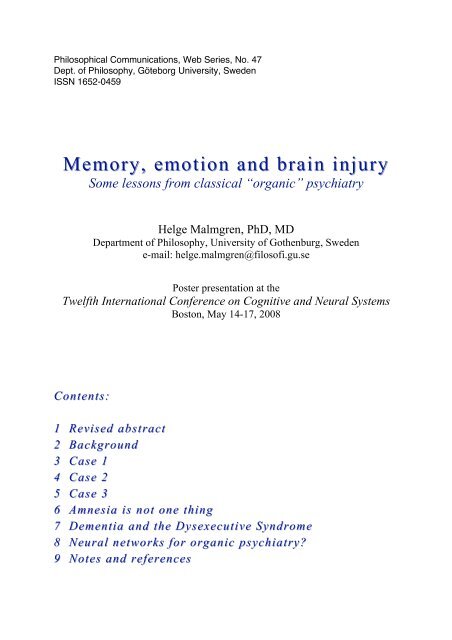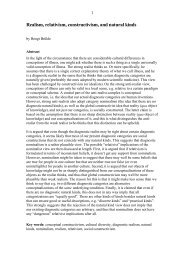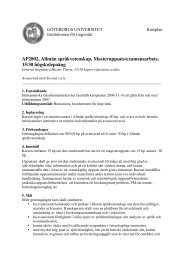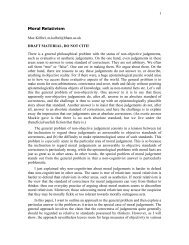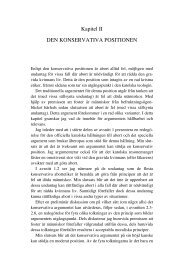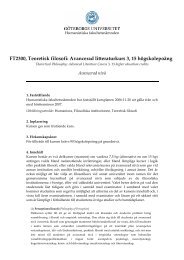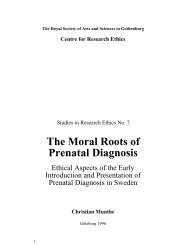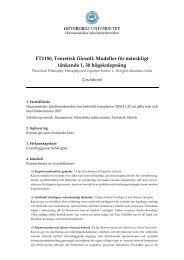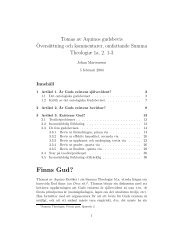Memory, emotion and brain injury Memory, emotion and brain injury
Memory, emotion and brain injury Memory, emotion and brain injury
Memory, emotion and brain injury Memory, emotion and brain injury
Create successful ePaper yourself
Turn your PDF publications into a flip-book with our unique Google optimized e-Paper software.
Philosophical Communications, Web Series, No. 47<br />
Dept. of Philosophy, Göteborg University, Sweden<br />
ISSN 1652-0459<br />
<strong>Memory</strong>, <strong>emotion</strong> <strong>and</strong> <strong>brain</strong> <strong>injury</strong><br />
Some lessons from classical “organic” psychiatry<br />
Helge Malmgren, PhD, MD<br />
Department of Philosophy, University of Gothenburg, Sweden<br />
e-mail: helge.malmgren@filosofi.gu.se<br />
Poster presentation at the<br />
Twelfth International Conference on Cognitive <strong>and</strong> Neural Systems<br />
Boston, May 14-17, 2008<br />
Contents:<br />
1 Revised abstract<br />
2 Background<br />
3 Case 1<br />
4 Case 2<br />
5 Case 3<br />
6 Amnesia is not one thing<br />
7 Dementia <strong>and</strong> the Dysexecutive Syndrome<br />
8 Neural networks for organic psychiatry<br />
9 Notes <strong>and</strong> references
Revised abstract<br />
Brain injuries <strong>and</strong> <strong>brain</strong> illnesses provide a very important empirical<br />
foundation for the construction of neural network models of <strong>brain</strong><br />
functioning. If one wants to base such models on neuropsychological or<br />
neuropsychiatric data, it is of course essential that the clinical syndromes<br />
are described properly. A truly astonishing wealth of relevant observations<br />
has accumulated during the last decades. However, it can be argued that<br />
the basic underst<strong>and</strong>ing of these syndromes by the present generation of<br />
psychiatrists <strong>and</strong> neuropsychologists still suffers from the radical break<br />
with traditional European psychiatry which occurred when the new<br />
American diagnostic <strong>and</strong> classificatory system for psychiatry (DSM-III,<br />
DSM-IV) was launched <strong>and</strong> accepted as the new basis for psychiatric<br />
thinking. Especially when it comes to modelling <strong>brain</strong> systems of memory<br />
<strong>and</strong> <strong>emotion</strong>, the neural network research community should benefit from<br />
a review of some facts which were lost in that transition. In the present<br />
paper, which is based on a comprehensive update of the classical European<br />
diagnostic systems that I participated in some years ago, I focus on three<br />
such less well-known facts pertaining to memory <strong>and</strong> <strong>emotion</strong>:<br />
The classical so-called “frontal lobe syndrome” is not seldom caused<br />
by extra-frontal pathology. This fact, which has been known since<br />
the 1920’s, clearly motivates a conceptual change. Emotional-<br />
Motivational Blunting Disorder (or EMD for short) is a construct<br />
designed to fulfil this purpose. The DSM alternatives are deficient in<br />
that they do not respect next point.<br />
It is extremely important to distinguish the <strong>emotion</strong>al flattening seen<br />
in EMD from the <strong>emotion</strong>al lability which is a common effect of<br />
many different <strong>brain</strong> pathologies. Many taxonomies create confusion<br />
on this point. Emotional lability is a component of what we call<br />
Astheno-Emotional Disorder, or AED for short. Mental fatiguability<br />
<strong>and</strong> memory disturbances (mainly due to concentration difficulties)<br />
are other core symptoms of AED.<br />
The use of the seemingly general term “Amnes(t)ic Syndrome” to<br />
designate an – albeit very important – subgroup of memory deficits is<br />
misleading, considering that AED is the most common cause of<br />
memory disturbances in organic psychiatry. It is suggested that one<br />
instead use Korsakoff’s Amnestic Disorder, or KAD for short.<br />
1
Background<br />
In the early 1970’s, the author entered an interdisciplinary cooperation<br />
with a leading European specialist in organic psychiatry, Göran Lindqvist.<br />
A specialist in both internal medicine <strong>and</strong> psychiatry, working first in<br />
departments of geriatrics, internal medicine <strong>and</strong> endocrinology, <strong>and</strong> then<br />
for two decades as a consultant psychiatrist in a neurosurgical university<br />
clinic, GL amassed an almost unique experience in the organic psychiatric<br />
field. Among other things, he was the first to report the occurrence of the<br />
Korsakoff’s amnestic syndrome after rupture of an aneurysm on the<br />
anterior communicating artery. 1<br />
The present author’s had had some psychiatric experience already in<br />
the 1970’s, but his main contribution to the cooperation was his expertise<br />
in philosophical issues concerning classification, scientific explanation <strong>and</strong><br />
the body-mind problem. Together, GL <strong>and</strong> HM published a comprehensive<br />
treatise on organic psychiatry in 1990 – regrettably, only in Swedish! 2 An<br />
English summary of it was published in 1993, but the international impact<br />
of the book has of course been negligible. 3<br />
The classificatory system in the book (below: the LM system) has its<br />
roots in classical European psychiatry: Eugen Bleuler, Manfred Bleuler,<br />
Karl Jaspers, Claus Conrad <strong>and</strong> many others. It is opposed to DSM-III/IV<br />
in that it is not a-theoretical. 4 I.e., the disorders are not defined strictly in<br />
terms of observable symptoms <strong>and</strong> signs. The LM system is however not<br />
etiologically based either. Indeed, one of the main points made in the book<br />
is that the same disorder can be caused by many different etiological<br />
agents – as a rule even by differently located <strong>brain</strong> injuries. Instead, the<br />
basic categories are thought of as hypothetical psychopathogenetic<br />
processes. These processes typically have certain observable<br />
manifestations, by means of which they can be empirically specified.<br />
However, through clinical <strong>and</strong> theoretical considerations the underlying<br />
processes can also be identified in non-typical cases where the usual<br />
empirical criteria are not fulfilled. Among these cases are, importantly,<br />
those where the disorder-process in question interacts with other, cooccurring<br />
disorders. Multiple diagnoses are thus possible, <strong>and</strong> indeed they<br />
should be the rule rather than the exception.<br />
These principles will now be illustrated through three case histories<br />
(abbreviated <strong>and</strong> translated from Lindqvist & Malmgren 1990).<br />
2
Case 1<br />
At the age of 50, this female patient noted a progressively raised<br />
mental fatiguability, irritability <strong>and</strong> <strong>emotion</strong>al lability. External signs of<br />
acromegaly were noted at the age of 54, <strong>and</strong> with time she developed<br />
diabetes <strong>and</strong> heart insufficiency. At 64, the symptoms became much<br />
worse, <strong>and</strong> the patient complained of headache <strong>and</strong> severe fatigue. X-ray<br />
therapy directed towards the hypophysis had no certain effect <strong>and</strong> a transsphenoidal<br />
hypophysectomy was therefore performed when the patient<br />
was 66. Her endocrinological status after the operation was satisfactory<br />
<strong>and</strong> overall she improved somatically, but three years later she died from<br />
cerebrovascular causes.<br />
At the preoperative psychiatric assessment, the patient was tired <strong>and</strong><br />
<strong>emotion</strong>ally very labile, <strong>and</strong> she complained about her severe<br />
forgetfulness, but the contact with the physician was very warm <strong>and</strong><br />
natural. However, a few weeks after the operation – when the acute postoperative<br />
lowering of wakefulness had regressed – it was obvious that her<br />
personality had changed. She showed very little interest in what happened<br />
around her. She answered questions very briefly <strong>and</strong> it was impossible to<br />
get a good personal contact with her. Her mood was a shallow euphoria<br />
which however turned into irritation when people asked her difficult<br />
questions. – A couple of months later, there was some improvement, but<br />
she was still not interested in upholding a good <strong>emotion</strong>al contact. She also<br />
seemed to have completely lost her sense of hygiene. – Later on, her<br />
condition improved gradually, <strong>and</strong> three years after the operation all the<br />
mentioned symptoms had disappeared. This was testified by the patient’s<br />
close relatives <strong>and</strong> was confirmed by the clinical examination.<br />
Before the introduction of DSM-III, the post-operative diagnosis for<br />
this patient’s condition would have been frontal lobe syndrome. However,<br />
it is quite improbable that her operation should have done any damage to<br />
frontal structures. Instead, the case illustrates the fact that the so-called<br />
“frontal lobe syndrome” not seldom has an extra-frontal aetiology. In the<br />
LM system, the etiologically neutral name Emotional-Motivational<br />
Blunting Disorder, or EM disorder for short, is therefore used. 5<br />
What about this patient’s condition before the operation Let us have a<br />
look at another case to illustrate this.<br />
3
Case 2<br />
At the age of 37, this male patient started feeling more tired after work<br />
than usual. After nine months this fatiguability had become worse, <strong>and</strong> the<br />
patient also experienced concentration difficulties, forgetfulness <strong>and</strong> some<br />
<strong>emotion</strong>al lability. Three months later a meningeoma at the left frontal<br />
convexity was diagnosed. At the preoperative psychiatric assessment, the<br />
patient seemed to be intellectually intact. He showed a natural spontaneity<br />
<strong>and</strong> initiative <strong>and</strong> his judgment was not impaired, but it was obvious that<br />
he easily got tired. This was especially the case when the task dem<strong>and</strong>ed<br />
continuous attention. He also became uncertain when put to memory tasks.<br />
The results on tests for concentration <strong>and</strong> memory were very weak, but<br />
there was no tendency to confabulation on the memory tests. – After the<br />
operation, the patient’s condition improved rapidly. He got back into work<br />
already after a couple of months, <strong>and</strong> then reported that his mental<br />
condition was the same as before the illness.<br />
One interesting thing with this case is that although it was obviously<br />
caused by a frontal tumour, its symptomatology has nothing in common<br />
with the classical frontal lobe syndrome. There is no loss of initiative, no<br />
shallow euphoria, no disinhibition. The patient’s judgment <strong>and</strong> his ability<br />
for <strong>emotion</strong>al contact are intact. True, there is an <strong>emotion</strong>al lability, but<br />
this must not be confused with the <strong>emotion</strong>al shallowness of the EM<br />
disorder. So how should we classify his disorder In DSM-IV, the label<br />
Cognitive Disorder Not Otherwise Specified might be used for this<br />
patient’s condition. However, his <strong>emotion</strong>al lability is not included in that<br />
concept so one might instead consider Personality Change Due to Brain<br />
Tumor, Labile Type. But that would not cover his cognitive difficulties.<br />
In the LM system, there is a concept that includes both the cognitive<br />
<strong>and</strong> the <strong>emotion</strong>al symptoms: Astheno-Emotional Disorder, or AE<br />
disorder (or AED) for short. Looking back to Case 1, it should be obvious<br />
that the pre-operative psychiatric condition of that patient was very like<br />
that of the present one, only that the <strong>emotion</strong>al lability was more marked in<br />
her case. In short, she also had an AED. Indeed, AED is seen with a great<br />
multitude of etiological factors like head trauma, tumours of any location,<br />
endocrinological disturbances, infections, <strong>and</strong> ischemic <strong>and</strong> degenerative<br />
<strong>brain</strong> disease of old age. In the last-mentioned context, AED is better<br />
known as “Mild Cognitive Impairment”, MCI. 6 But why use a specific<br />
term for each clinical context, when there is one which covers them all 7<br />
4
Case 3<br />
This man fell ill at the age of 67 with an attack of temporary loss of<br />
consciousness. One week later a similar incident occurred again <strong>and</strong> now a<br />
left hemiplegia remained. A subarachnoidal bleeding was diagnosed, <strong>and</strong><br />
the patient was operated with ligation of a ruptured aneurysm on the<br />
anterior communicating artery. This was before the microneurosurgical<br />
era <strong>and</strong> the operation was technically difficult, but there were no somatic<br />
postoperative complications.<br />
At the psychiatric assessment before the operation the patient was very<br />
tired <strong>and</strong> could not uphold his interest for the questions asked. His<br />
judgment <strong>and</strong> his ability for abstract thought seemed essentially intact,<br />
however. His results on memory tests were weak but he did not<br />
confabulate <strong>and</strong> he was fully oriented.<br />
One day after the operation there were several marked changes in his<br />
mental condition. He was more alert <strong>and</strong> gave quick <strong>and</strong> formally adequate<br />
responses to questions. However, he was deeply disoriented both spatially<br />
<strong>and</strong> temporally, <strong>and</strong> did for example not know how old he was. He could<br />
not memorize what he was told, but gave some adequate information about<br />
his earlier life. – Some tens days later he was moved to another room <strong>and</strong><br />
then became irritable <strong>and</strong> more difficult to h<strong>and</strong>le. At the same time he<br />
seemed remarkably indifferent <strong>and</strong> never took an initiative towards<br />
talking. – Two weeks after the operation, he could adequately report about<br />
the events before the operation, with the exception of the days immediately<br />
preceding it. He was still disoriented <strong>and</strong> did not remember a single one of<br />
five presented objects after three minutes. He confabulated readily. This<br />
state prevailed for the remaining three weeks at the hospital.<br />
After that there was a gradual recovery, but his <strong>emotion</strong>al indifference<br />
<strong>and</strong> lack of interest in his close relatives were a concern for some time.<br />
Two <strong>and</strong> a half months after the operation, his daughter thought that the<br />
father was the same as before except perhaps for some remaining<br />
indifference. At the psychiatric assessment he was quite oriented <strong>and</strong> his<br />
judgment seemed to be normal. Although the results on some memory<br />
tests were as bad as before the operation, other were better <strong>and</strong> there was<br />
no confabulation.<br />
5
Amnesia is not one disorder<br />
Amnesic (or Amnestic) Disorder (or Syndrome) is a common<br />
designation for this patient’s condition after the operation. The first point<br />
to be made from a conceptual point of view is that these names invite a<br />
confusion between the kind of memory disturbance that prevailed after the<br />
operation <strong>and</strong> the memory problems that the patient had immediately<br />
before. With a high probability, the latter problems were at least partly due<br />
to a concurrent astheno-<strong>emotion</strong>al (AE) disorder, i.e. they were of the<br />
same nature as the memory difficulties that we saw in Case 1 <strong>and</strong> Case 2.<br />
Since memory difficulties due to AED are more common in clinical<br />
practice than such due to the so-called Amnestic Syndrome, it is better to<br />
have a more specific name for the latter. We have therefore suggested the<br />
use of Korsakoff’s Amnestic Disorder, or KAD for short. Korsakoff<br />
described all the essential features of the syndrome in the 1880’s,<br />
including the remarkable fact that implicit learning can be preserved. 8<br />
Historically, the term “Korsakoff’s syndrome” has been associated with a<br />
specific aetiology of the syndrome (alcoholism), <strong>and</strong> sometimes with<br />
symptoms other than the amnestic ones. However, in the absence of clear<br />
evidence to the contrary one may presume that the amnesia is essentially<br />
the same in alcoholic cases with dysfunction of the mammillary bodies or<br />
the medial thalamus as in, for example, bilateral hippocampal damage.<br />
(How else could Korsakoff’s descriptions fit the famous case of HM so<br />
well) That different locations may produce some clinical differences is<br />
obvious, but this does not entail that we should use different diagnoses.<br />
The second point to be made from Case 3 is that it reminds us that<br />
Korsakoff’s amnestic disorder is not seldom transient. The paradigm<br />
example of this is of course the so-called “Transient Global Amnesia”<br />
(TGA), which has all the characteristics of KAD. 9 We also believe that the<br />
common “memory gap” that often remains after a head trauma is a<br />
manifestation of an (otherwise) rapidly transient KAD.<br />
The third point is the co-existence in this case of three organic mental<br />
syndromes: Korsakoff’s Amnestic Disorder, Astheno-Emotional Disorder<br />
<strong>and</strong> Emotional-Motivational Blunting Disorder. During the acute postoperative<br />
phase, only the KAD <strong>and</strong> the EMD were visible. However, the<br />
memory deficits early <strong>and</strong> late in the course were probably mainly due to<br />
an AED. It may be presumed that the latter disorder was present even<br />
when the KAD <strong>and</strong> the EMD dominated the clinical picture.<br />
6
Dementia <strong>and</strong> the Dysexecutive Syndrome<br />
Dementia is an essentially socio-functional concept that comprises<br />
many different clinical pictures <strong>and</strong> many different somatic aetiologies.<br />
We have found it fruitful to look at the symptomatology of the dementias<br />
in terms of the three “big” disorders AED, KAD <strong>and</strong> EMD. Nearly all<br />
dementia cases can be analyzed as containing more or less of each of these<br />
three components. The composition often varies over time <strong>and</strong> at the<br />
beginning only one of the disorders may be manifest. A dementia from<br />
cerebrovascular causes usually starts with AED (“MCI”) symptoms <strong>and</strong> is<br />
long dominated by more <strong>and</strong> more severe symptoms of this kind.<br />
Alzheimer’s disease is more prone to begin with discrete symptoms of<br />
EMD or even KAD, <strong>and</strong> even when AED are the first symptoms the other<br />
two components usually soon make their appearance. This is of course not<br />
surprising in view of the common location of the Alzheimer disease<br />
process to temporo-frontal areas. It goes without saying that beside<br />
manifestations of the three mentioned disorders, most dementia cases also<br />
show diverse focal neurological symptoms <strong>and</strong> signs such as aphasia.<br />
The Dysexecutive Syndrome is a controversial construct which is<br />
defined differently by different authors. It is however thought by all of its<br />
proponents to comprise certain disturbances of higher cognitive<br />
(“executive”) functions <strong>and</strong>, importantly, to be “frontal” in nature. 10 Some<br />
of the definitions of the concept indeed reminds one of the classical<br />
“frontal lobe syndrome”, but other definitions hardly mention <strong>emotion</strong> <strong>and</strong><br />
motivation. In our view, the concept is the result of not realizing that<br />
frontal damage can give rise to two distinct organic mental disorders:<br />
astheno-<strong>emotion</strong>al disorder (AED) <strong>and</strong> <strong>emotion</strong>al-motivational blunting<br />
disorder (EMD). Of these, AED occurs in a lot of other locations of the<br />
<strong>brain</strong> pathology, <strong>and</strong> even with frontal damage it is more common than<br />
EMD. EMD, in turn, does not occur only with frontal lesions but also as a<br />
consequence of pathologies of extra-frontal, limbic structures. 11<br />
A crucial issue in the differentiation of AED <strong>and</strong> EMD is the<br />
distinction between <strong>emotion</strong>al lability <strong>and</strong> <strong>emotion</strong>al (<strong>and</strong> motivational)<br />
shallowness. EMD leads to a change in the patient’s personality because<br />
her basic <strong>emotion</strong>al attitude towards others <strong>and</strong> her ambitions about her<br />
own future are affected. In contrast, a patient with AED (only) is the same<br />
person as before, intellectually as well as motivationally <strong>and</strong> <strong>emotion</strong>ally,<br />
but more prone to mental fatigue <strong>and</strong> <strong>emotion</strong>al over-reactions.<br />
7
Neural networks for organic psychiatry<br />
Much effort is now concentrated on analyzing internal <strong>and</strong> external<br />
hippocampal circuits in order to underst<strong>and</strong> the amnestic syndrome on a<br />
neural network level. There is a popular view to the effect that amnesia =<br />
hippocampal damage, but most researchers of today surely know that nonhippocampal<br />
lesions, for example in the mammillary bodies or medial<br />
thalamus, may cause a full-blown Korsakoff’s amnestic disorder (KAD).<br />
Not so many are aware that most organic memory disturbances are not due<br />
to KAD. Both facts must be taken account of in the neural network theory.<br />
Contemporary speculations about the neural networks underlying<br />
<strong>emotion</strong> often focus on conditioned fear <strong>and</strong> its supposed anatomical locus<br />
in the amygdalae. However, another equally urgent task is to underst<strong>and</strong><br />
the <strong>brain</strong>’s innate motivational <strong>and</strong> <strong>emotion</strong>al circuits on a detailed<br />
network level. The clinical evidence – especially, of course the evidence<br />
pertaining to the <strong>emotion</strong>al-motivational blunting (EM) disorder – shows<br />
that these circuits include a much wider area, indeed the whole of the<br />
(fronto-)limbic system. The scientific community’s interest in this system<br />
has been rather low during the last decades. This is probably partly due to<br />
the abovementioned misunderst<strong>and</strong>ings about “frontal” symptoms, <strong>and</strong><br />
partly to the way <strong>emotion</strong>al disturbances are categorized in DSM-III/IV.<br />
Astheno-<strong>emotion</strong>al (AE) disorder poses a great challenge for neural<br />
network theorists. The way AED manifests itself is a paradigm case of<br />
graceful degradation: top intellectual <strong>and</strong> <strong>emotion</strong>al capacity are kept very<br />
long, but the efficiency of cognitive <strong>and</strong> <strong>emotion</strong>al processing is gradually<br />
diminished when the disorder worsens. The fact that the disorder can be<br />
caused by lesions at almost any location is intriguing. The immediate<br />
cause of the symptoms could be a structural or functional disturbance of a<br />
network that is physically distributed over almost the whole <strong>brain</strong>. A more<br />
probable explanation, though, is that the underlying network itself is more<br />
strictly localized but that its proper functioning depends on its receiving<br />
normal input from a host of other <strong>brain</strong> areas. Such an hypothesis becomes<br />
even more probable if one considers that AED affects high-level, nondomain-specific<br />
cognitive functions such as the capacity to uphold<br />
continuous attention on any current topic. To serve such capacities, the<br />
network must of course receive convergent input from many domains.<br />
Being built to coordinate such input, it is no wonder if its performance<br />
becomes degraded when part of the input falls outside the normal range.<br />
8
Notes <strong>and</strong> references<br />
1 Lindqvist, G. & Norlén, G. (1966). “Korsakoff’s syndrome after operation on ruptured aneurysm<br />
of the anterior communicating artery.” Acta Psychiatrica Sc<strong>and</strong>inavica 42, 24-34.<br />
2 Lindqvist, G. & Malmgren, H. (1990). Organisk Psykiatri. (Organic Psychiatry. In Swedish)<br />
Stockholm: Almqvist & Wiksell.<br />
3 Lindqvist, G. & Malmgren, H. (1993). Classification <strong>and</strong> Diagnosis in Organic Psychiatry. Acta<br />
Psychiatrica Sc<strong>and</strong>inavica 88, Suppl. 373. Copenhagen: Munksgaard.<br />
4 American Psychiatric Association (1980). Diagnostic <strong>and</strong> Statistical Manual of Mental Disorders,<br />
3rd Edn. (DSM-III). Washington DC: American Psychiatric Association. – American Psychiatric<br />
Association (2000). Diagnostic <strong>and</strong> Statistical Manual of Mental Disorders, 4th Edn. Text<br />
Revision (DSM-IV-TR). Washington DC: American Psychiatric Association.<br />
5 There is not room to discuss alternative concepts in detail here but the DSM-III term “Organic<br />
Personality Syndrome” should be mentioned. Regrettably, the definition of this concept includes<br />
<strong>emotion</strong>al lability which means that many patients with AE disorder (see page 4) must have been<br />
given the diagnosis Organic Personality Syndrome (along with patients with EMD).<br />
6 For a review of this concept see for example Mariania, E., Monasterob, R. & Mecocci, P. (2007).<br />
“Mild Cognitive Impairment: A Systematic Review.” Journal of Alzheimer’s Disease 12, 23–35.<br />
7 For details about the AED concept, including the relation between it <strong>and</strong> some past <strong>and</strong> recent<br />
constructs, see also Malmgren, H. (1998). “Without a proper definition, you do not see the<br />
phenomenon. The history of a missing diagnosis.” Philosophical Communications, Green Series<br />
60, 1998. Gothenburg: University. Internet: http://www.phil.gu.se/posters/ae.html<br />
8 Korsakoff tried to treat some of his patients with a kind of electrotherapy <strong>and</strong> noted that one of his<br />
amnesic patients always went into “a bad mood” when he saw the electrical apparatus – in spite of<br />
not remembering having seen it before. He also noted that several patients developed <strong>emotion</strong>al<br />
reactions to the people at the ward although they never learned to recognize them. Korsakoff, S.<br />
(1996). “Medico-Psychological Study of a <strong>Memory</strong> Disorder.” Consciousness <strong>and</strong> Cognition, 5,<br />
2-22. This paper is a translation of Korsakoff, S. (1889). “Étude médico-psychologique sur une<br />
forme de maladies de la mémoire.” Revue Philosophique 28, 501-30. Compare also the following<br />
comment by one of the translators: “Neuropsychological findings have revolutionized the study of<br />
memory in the last decade <strong>and</strong> a half. Virtually all of the findings considered important about<br />
anterograde amnesia were reported by Korsakoff, <strong>and</strong> some that he reported still have not had the<br />
impact they should on current thinking.” Banks, W. (1996). “Korsakoff <strong>and</strong> amnesia.”<br />
Consciousness <strong>and</strong> Cognition, 5, 22-26.<br />
9 For a recent illustrative case report see Saito, K., Kimura, K., Minematsu, K., Shiraishi, A. &<br />
Nakajima, M. (2003). “Transient global amnesia associated with an acute infarction in the<br />
retrosplenium of the corpus callosum.” Journal of the Neurological Sciences 210, 95–97<br />
10 Stuss, D. & Alex<strong>and</strong>er, M. (2007), “Is there a dysexecutive syndrome”. Philosophical<br />
Transactions of the Royal Society of London, B series, 362, 901–915. The authors of this paper<br />
betray a generally high methodological awareness but seem not to have considered that evidence<br />
from exclusively non-frontal lesions is needed if one wants to tie a syndrome aetiologically to<br />
(subregions of) the frontal lobes. Most of the results that they report can be given an alternative<br />
theoretical account in terms of mixtures of EM <strong>and</strong> AE disorders.<br />
11 This may be the reason why temporal lobectomy for otherwise intractable epilepsy sometimes<br />
improves “executive functioning”. Cf. Martin, R., Sawrie, S., Edwards, R., Roth, D., Faught, E.,<br />
Kuzniecky, R., Morawetz, R. & Gilliam, F. (2000). “Investigation of Executive Function Change<br />
Following Anterior Temporal Lobectomy: Selective Normalization of Verbal Fluency”.<br />
Neuropsychology 14, 501-508. (Thanks to Kristina Malmgren for pointing out this.)<br />
9


